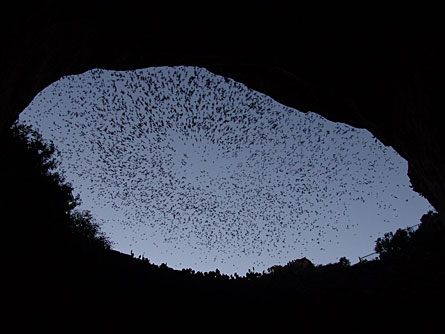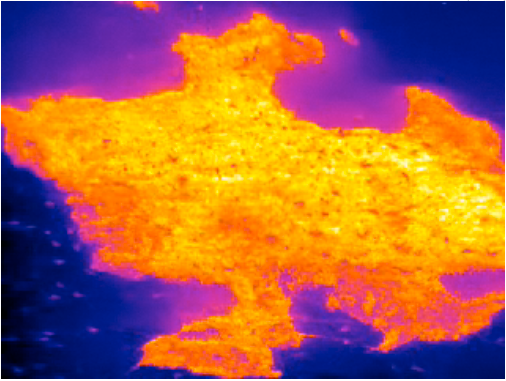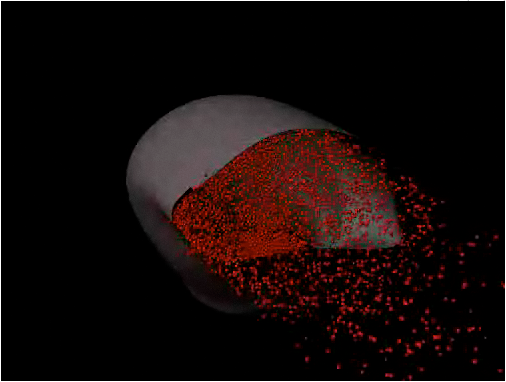Eight million is a lot of bats to lose, and now a new unpublished study may explain what happened to the possibly lost bats of Carlsbad Cavern.




Short answer: According to a Boston University team, the famous 8 million bats never existed in the first place.
From spring to fall, the cave Carlsbad Cavern in New Mexico’s Carlsbad Caverns National Park still hosts hundreds of thousands of migratory Brazilian free-tailed bats that thrill visitors by boiling out of the cave at dusk for a night’s foraging. All the bats roosting in the cave emerge in a dense plume that streams on and on and on, sometimes for an hour or three.
As with many wildlife spectacles these days, always present is the disturbing possibility that today’s show is a mere wisp compared to the great Carlsbad bat clouds of yore.
In 1937 V.C. Allison published an estimate of the Brazilian free-tailed bat numbers based on timing an emergence (14 minutes at great density; four minutes at half that) and eyeballing the speed and size of the stream. About 8.7 million bats roost in the cavern, he reported.
Since then, methods and numbers have varied, but estimates haven’t topped a million. Consequently, conservationists have raised alarms about perils to bats. Or maybe Allison’s eyeballs played tricks on him, or the great emergence flights really have shrunk drastically.
Starting in 2005, bat scientist Thomas Kunz of Boston University and colleagues brought new technology to Carlsbad Cavern to count and observe the animals. Parts of the cave where bats roost are closed to visitors to prevent disturbances to the animals. But to improve the census and studies, the park allowed Kunz’s team to venture into these portions of the caves.
One of the first field biology groups to use military-derived thermal imaging, Kunz’s team attracted the U.S. Park Service’s interest by pointing out that the researchers didn’t need to shine any lights, even at infrared wavelengths, on the bats; the cameras detect heat directly.
“Surreal” and “disgusting, yet absolutely amazing” is how Nickolay Hristov, now at Brown University in Providence, R.I., describes the roosting sites. “Imagine standing on a 20- to 30-foot cushion of bat poop covered with a constantly moving carpet of dermestid beetles and their larvae,” he says.
“As you move around you are being rained on by bat urine,” Hristov says. Bat excretions don’t have the same odor as human equivalents, he says, but “the smell of ammonia is so strong that your eyes burn.” A single bat barely makes any noise that humans can hear but tens of thousands of them together get “quite loud,” he says. ”I would grab the camera and go back in a heartbeat.”
To count the bats emerging, the researchers set up cameras around the cavern mouth to get a clear view of the stream. Margrit Betke of Boston University’s computer science department developed algorithms for analyzing the camera’s recordings. Her work basically allowed a computer to pinpoint bats as spots in a camera frame and then track the spots across enough frames to confirm the dots were indeed bats. The analysis ends up with a count of each spot in the vast stream.
In a series of counts in 2005, numbers varied from a low of not quite 70,000 as bats started to arrive from their southern winter caves, to a peak about 10 times higher weeks later as migrating bats on their way elsewhere took shelter.
Even at the peak, counts came up some 8 million bats short of the old estimate. So the Boston team used the Brazilian free-tails’ average 0.28-meter wingspread to model how many bat wing-beat “spheres” would fit through the cavern in a minute.
A choke point inside the cavern narrows to only 120 square meters, and bats don’t fly wall-to-wall. At most, 50,000 bats per minute could fit through that choke point and emerge from the cavern mouth. Thus a single million would be closer to the number of bats possible that wowed Allison.
For 8.7 million bats to have flown through the choke point in 18 minutes, as Allison reported, the densest crowd would have had to pass through at 500,000 bats per minute. Their wings and bodies would have had to pass through each other to somehow squeeze through the passage.
“The Boston study clearly shows there’s no physical way that could happen,” says Renée West, supervisory biologist for Carlsbad Caverns National Park. “That’s a relief.” The park has discounted Allison’s numbers as excessive, she says, and she’s glad to have the new analysis.
“That doesn’t mean these bats aren’t declining,” Hristov says. “The declines just haven’t been as bad.”
And for the cavern’s human visitors, hundreds of thousands is still a lot of bats.






